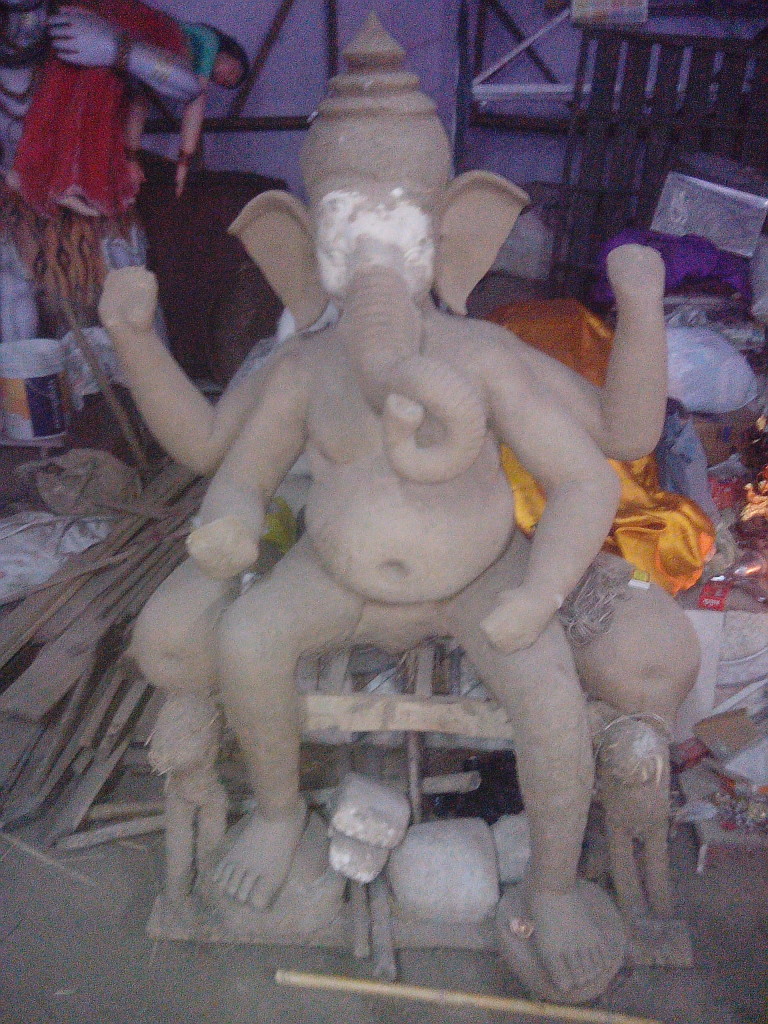Brief History:
Ganesh Chaturthi or Vinayaka Chauth as it is called is celebrated on Bhaadrapada on the (shukla chaturthi) 4th day of the waxing period of moon or the 4th day of the lunar cycle. It was first celebrated by the great Maratha King Shivaji (1630-1680), then later Bhausaheb Laxman Javale in 1892 for the first time celebrated Ganesh Chaturthi (The Sarwajanik Ganesh puja or installed Ganesh idol in a public place) – Shrimant Bhausaheb Rangari Ganpati at BHUDHWARA Peth in Pune, then at his residense known as Bhau Rangari Bhavan at Bhudwar Peth in Pune then later Lokmanya Tilak appraised it in Kesari news paper then celebrated s it at Kesari wada.

In this way time on and off it has taken much of the grandeur and glorious pomp.
Mythological Aspect:
The mythological aspect to it is Lord Ganesha is believed to be the virtuous son of Lord Shiva and Ma Parvati, the goddess of Shakti or the embodiment of Shakti, and the particular look of Ganesha goes like this that once his mother Parvati went for bath and commanded her son Ganesha not let anyone get in. Traditionally as the hindu belief goes out that lord Ganesha was created by Parvati the consort of Lord Shiva, out of sandalwood paste which she used for her bath and then breathed life into the idol then ordered little Ganesha not to let anyone inside and left for bath. Even when Shiva tried to step in at the threshold he didn’t let him, Shiva furious sent his Ganas to teach a lesson to Ganesha, in between Narada the sage of heavens with Saptakrishi sensing the turmoil headed off to appease the lad, king of gods Indra, even attacked but nothing could help then it came into account that Ma Parvati’s orders were being carried off by her son so vigilantly, but by then sensing humiliation out of rage Lord Shiva severed the head of his own son knowing the truth and sensing the grim mistake that has been committed, he ordered them to bring the head of a dead person found facing north but alas in north direction only a dead elephants was found thus the dramatic elephant headed look of our Ganaisha or the lord of Ganas. In Linga Purana he has been designated as Vighnakartaa or trouble maker for the Asuras (demons) and Vighnahartaa (trouble averter) obstacles for gods or good souls.
In different parts it is celebrated with much festivity and grandeur.
GC’s Views in Restoration/Conservation:
But whatever the celebration is, Glucose Club celebrates every moment and keeps an eye if nature is secure and free from all toxic pollutants. Thus to take a step further Glucose Club went out to find out whether the idols that has been made are how eco-friendly and had a face to face talk with the murtikar (idol makers) along with puja committees. Different materials in raw form were seen and how the puja committees planning to manage and secure the health and wealth of mother nature as in different parts of the country especially in Maharashtra and other neighboring states statues are made up of Plaster of Paris (POP) which is highly toxic and not even biodegradable, but now under the supervision of some responsible committees from different parts of the country news is pouring in of making idols out of plain river bed soil, or paper mache, or brass/silver statues are worshipped every year and visarjan/immersion takes place in a ritual way at home only and again next year the same statue is worshipped, even small little tanks or huge tubs are temporarily built to immerse the idols ritually and then transporting the soil for cultivation to gardens/agricultural fields thus even having a satisfied feeling that our Ganesha and his powers are with us only enriching and empowering us everyday and the soil is transported after cleaning from it all the decorative articles may it be metallic/beaded/synthetic/wooden or in any other form, leaving behind plain smooth soil enriched with the powers of lord Ganesha.
Glucose Club is strictly preaching this form of immersion and personally I am practicing it in my garden small to medium sized idols that I buy every year are kept in the landscapes of my garden and during rains it melts away into the soil thus making it more fertile each year, even I have tried my hands on making Ganesha with paper and leaf which are again but biodegradable gives a immense feeling of internal satisfaction that I/we as Glucose Club is taking small tiny steps which will surely make a mammoth difference in the coming years.
During the past by gone eras all the ten days of celebration were done with eatables, leaves and flowers these things acted as fodder for the aquatic animals/mammals and all the herbal leaves/flowers purified the water after visarjan/immersion of the clay idols in one form or the other as then there were no such chemical affluent waste toxifying the rivers or any other water resource like today thus people used to take their response rightly then but now people have gone lazy and want to have everything on a fast track basis.
Now even durba (fine tips of long grass) is used for auspiciousness but overall we have to keep in mind no matter what we have to be responsible towards Mother Nature who is the janani (mother) of all origin.
to be continued…
Part 2 – Read Here
Part 3 – Read Here